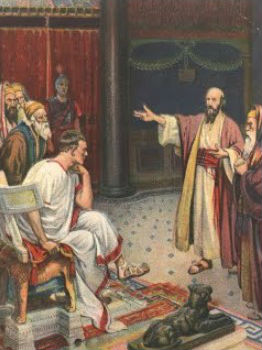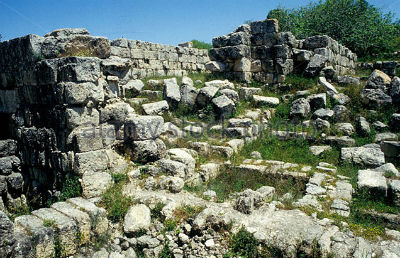The Bible, History and HISTORIE
By Neil Earle
 Gerhard von Rad (1901-1971) kept interest alive in Old Testament history in Nazi Germany.
Gerhard von Rad (1901-1971) kept interest alive in Old Testament history in Nazi Germany.There are German words that have travelled around the world. “Kindergarten” is one. “Angst” is another, as is “Zeitgeist.” And don’t forget “kaput.” Over the years Bible teachers have coined another German word that, when used properly, can help readers better understand the books from Genesis to Revelation.
The word is “Heilsgeschichte” – roughly translated “salvation history” – and it not only provides a key to reading the Bible more accurately but helps us understand the true God’s actions in history and his purposes.
How so?
Let’s begin with a challenge from Professor Marc Van De Mieroop’s History of the Ancient Near East: “There are many elements that make the use of the Bible as a historical source suspect…The history of humankind was seen through the lens of how one related to the god Yahweh…Scholars have become increasingly critical about the use of the Biblical text in historical reconstructions” (page 210).
Well, not all scholars. Two generations back the eminent German textual critic Gerhard von Rad (1901-1971) wrote: “Israel indeed had a phenomenal sense of history, and her historical grasp manifested itself in innumerable ways...It would be difficult to find a nation [ancient Israel] so markedly preoccupied from its earliest days with the question of its own origins” (The Problem of the Hexateuch, pages 166, 168)
Bible History: A Case Study
The Old Testament books of First and Second Kings are the most political books in the Bible. “In the thirty-first year of Asa king of Judah, Omri became king of Israel, and he reigned twelve years, six of them in Tirzah. He bought the hill of Samaria from Shemer for two talents of sliver and built a city on the hill calling it Samaria, after Shemer…Omri did evil in the eyes of the Lord and sinned more than all those before him” 1 Kings 16:23-25).This brief account of the reign of King Omri (885-873BC), who gave the northern kingdom of Israel its capital of Samaria, gets just thirteen verses in the Bible story. He did evil, built Samaria and left behind his son, Ahab. That’s mostly it as far as the Bible writers were concerned. But the story runs differently in secular history. The meticulous Assyrian chroniclers to the north of Israel named Israel “Bit-Humri” or “land of Omri” (Walter Kaiser, A History of Israel). Archaeologists digging in Samaria have offered evidence for the actual existence of Ahab’s “buildings of ivory” (1 Kings 22:39).
Omri and Ahab were noted builders, successful warriors and ambitious traders. “Cypriot pottery appeared in Israel and Tyrian pottery was found in Palestine and Cyprus. What do these artifacts signify? They indicate trade between Tyre in Lebanon, the Northern Kingdom of Israel led by the house of Omri and the island of Cyprus” (Moore and Lewis, Origins of Globalization). “Excavations have laid bare Omri’s lavish building enterprises, projects continued by his son Ahab. The luxury [the prophet] Amos denounced a century later began under Omri” (Lasor, Hubbard and Bush, Old Testament Survey, page 201).
Omri shrewdly married his son Ahab to Jezebel, the crown princess of Tyre. Here is the sharp divide between historie and salvation history. Omri’s family is significant to Bible writers only because Ahab’s wife Jezebel brought Baal worship into Israel. This led to clashes with the prophet Elijah over rampant idolatry and corruption (1 Kings 21). Even though the Elijah/Ahab narrative occupies six chapters in the Bible we are told nothing about Ahab’s leading 2000 chariots at the Battle of Karkar, a battle which stopped the mighty Assyrians in 853BC. Instead, it was the Assyrians who dutifully recorded Ahab’s chariot force on their monuments (Hallo and Simpson, The Ancient Near East, page 127).
By now, we should not be surprised that secular history has a very different perspective on Omri and Ahab than the Bible. The Bible only obliquely mentions Ahab’s penchant for chariot fighting (1 Kings 22:35). That is not the main story. Ahab and Jezebel were undermining God’s covenant with Israel and jeopardizing its continued existence as a people. Israel’s writers, von Rad reminds us, were attempting “to comprehend the course of a history molded by God” (page 144). For that insight, we owe him a great debt.
(Neil Earle is a Los Angeles pastor and journalist who teaches a church history course online at Grace Communion Seminary.)
That German word Heilsgeschichte helps explain the difference between Professor Van De Mieroops’ conclusions and Dr. Von Rad’s. Let’s break this word down. According to the Collins German-English Bible Heilsgeschichte is “an interpretation of history stressing God’s saving grace.” This is more obvious in the German. The combination of “geschichte” (“story”) with “heilig” (“salvation”) clarifies. Another source defines the term as “an interpretation of history emphasizing God’s saving grace and viewing Jesus Christ as central in redemption.” This means readers of the Bible need to see a distinction between aspects of Salvation History and “Historie” – the German word for a more sequential, orderly arrangement of facts.
This distinction gives Bible readers some room to maneuver in an age where the Bible itself has been relegated to myth and misinformation, though this unfortunate distortion is now changing.
Uniqueness of Scripture
The Bible is history all right, but it is not exactly the kind we would study at a standard university. As even the Bible’s defenders acknowledge, the history detailed in the books from Genesis to Revelation proceeds by leaps and bounds leaving out large gaps of knowledge we would like to know more about. For example, there is not one fixed chronological date given. Instead, events are calibrated with other doings and personages in secular history as in Luke 3:1-2. Nevertheless, Bible history drives on relentlessly – sometimes seeming to meander but often subtly and indirectly – towards a central purpose. That central point revolves around the ultimate rescue of the human race wrapped up in the work of Jesus Christ, who in himself is the grand theme of the Bible.
So how can today’s readers make sense of all this? The Biblical text was compiled over a span of 1600 years by more than sixty authors living on three continents. Its documents embrace dim antiquity with stories such as the Flood and the Tower of Babel paralleled in other ancient writings. The answer, again, is that the God who claims to stand behind the words of the Bible has a specific purpose to accomplish in human history. The passing on of sheer factual data – general or secular history – is not the Bible’s main theme. This divine personage tells us through his messengers that “he knows the end from the beginning” (Isaiah 46:10), that he is often a “God who hides” (Isaiah 45:15) and, most importantly, that “his thoughts are not our thoughts” (Isaiah 55:8).
Here is where the concept of Heilsgeshitche can help. We are reminded that while the Bible contains a public history, with sometimes surprisingly minute and accurate details given us, the redemption of humanity is its main theme. Scholars such as Daniel Fuller prefer the term “redemption history” to “salvation history” (Studies in Old Testament Theology, page 66). Even so, Fuller admits his debt to Gerhard von Rad and the distinguished Oscar Cullmann (1902-1999). In Cullman’s view salvation or redemptive history unfolds in real space and time, an emphasis that should not be set aside by faddish Christian teachers. But the gaps and leaps in the Bible’s account were not a problem for Cullmann as they are for many – but not all – secular historians.
For Cullmann and von Rad, the Bible’s unique style of presentation was not illogical; it simply went beyond human-centered logic. Bible historians believed that “the selection of events is reached by the decision of God” (Cullmann, Salvation and History, page 154).
These orienting principles can soften the tension between the Bible and Historie. Let’s see the principle at work in the New Testament Book of Acts, from a writer who openly set his account in the context of his times.
 Fanciful reconstruction of Paul before Nero.
Fanciful reconstruction of Paul before Nero.“Facing the Lion”
Acts 13-28 focuses on the travels of the apostle Paul. After preaching across the Eastern Mediterranean, Paul is arrested on trumped-up charges. As a freeborn Roman citizen he appeals to the Roman emperor to hear his case. From reliable internal dating methods – e.g. the Roman’s own dates for the reign of governors Felix and Festus (Acts 24:27) – we know that when Paul sailed for Rome the emperor on the throne was Nero. Nero ruled from 55-68 AD and is no stranger to historians. Paul’s journey to plead before the emperor took place during the winter of 61-62 AD. Strangely, Nero’s first years were marked by a certain measure of restraint and competence. Even so, this was no man to take lightly, as William Barclay explains:
“The crimes of Nero make him one of the worst criminals in history. He arranged the murder of [his wife] Octavia; he kicked his second wife Poppaea to death when she was expecting a child…There is scarcely a crime in the calendar which Nero did not commit” (Ambassador for Christ, page 153). Nero’s extravagances and egotism still boggle the mind. His own Golden House spilled over three of Rome’s seven hills. In the vestibule he placed a 120 foot nude statue of himself as the Sun God, modeled on the Colossus of Rhodes (Crossan and Reed, In Search of Paul, pages 360-361).
This was the depraved madman who would hear Paul’s case. But what do we read of this mighty terrible Nero in Paul’s writings? Not a thing. His name is not mentioned. The nearest we get is Paul’s indirect reference in 2 Timothy 4:1 where he wrote about being “delivered from the lion’s mouth.”
Here is salvation history at work. The people who did get mentioned in Paul’s many letters are the ordinary church folk, the friends and supporters who helped underwrite his mission. When Paul drew near to Rome eager brethren from the Roman church came 32 miles to meet him (Acts 28:15). His letter to the Romans salutes 27 friends, most of whom would have been lost to history had it not been for him. Not only is Nero ignored but even the centurion who escorted Paul to Rome and treated him kindly stays anonymous (Acts 28:16).
Gaps and leaps again. The Roman Empire is important as a general historical background to Paul’s life but it is not essential to salvation history, to the kind of account Paul and his colleagues were writing with their own lives.
 Remains of Ahab's palace in Samaria – even Jezebel's seal may have been unearthed" (1 Kings 21:8).
Remains of Ahab's palace in Samaria – even Jezebel's seal may have been unearthed" (1 Kings 21:8).Elect people, Selected facts
Oscar Cullman summarized this approach to the Bible as history:
“All biblical salvation history rests upon the tacit presupposition that the selection of events is reached by the decision of God, and that the principle of this selection…is determined in the plan of God…God elects a people for the salvation of mankind [ancient Israel], and in this people he chooses the remnant, and finally the one man [Jesus Christ]; then the Church of those believing in the one man enters into this election for the salvation of all” (Salvation in History, page 154, emphasis his).
There, in essence, is the movement toward which Biblical history is working. As a theological tool the concept of Heilsgeschichte peaked in the middle of the 20th century. As Professor Tim Finlay explains: “Some pushed the distinction between sacred and secular history too far, which was a mistake.” As an interpretative tool or a primer for helping the average reader make sense of the Biblical text, however, the concept of redemptive history still has much to offer. Gaps and absences of chronology and sudden leaps in the narrative should not bother us once the overall course of the central story is understood. In the words of von Rad, “the reader is taught to look on God as the hidden Lord and ruler of history.” And that is a point of view the world sorely needs.